Table of Contents
Just getting started building up your site’s awareness and expertise? It may feel stressful, and your goals may seem unattainable — especially when you see top-ranked pages packed with actionable content by savvy marketing gurus. How can you even compete?
The Skyscraper Technique can help you by creating link-worthy content. The trick is nailing the details, such as capturing search intent, planning a worthwhile outreach strategy for building backlinks, and developing realistic expectations.
The technique is controversial and has a seemingly high fail rate. But there are steps you can take to ensure that you’re implementing it correctly to get the best possible outcome.
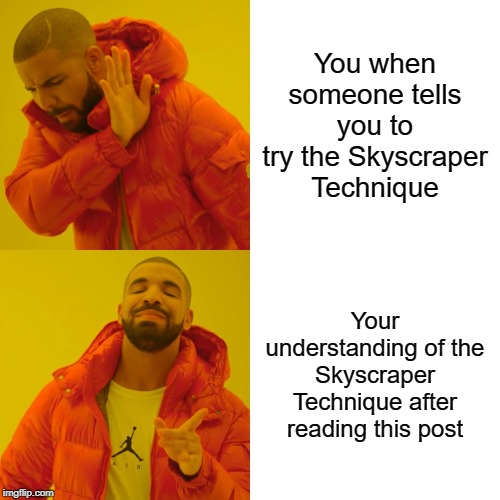
What is the Skyscraper Technique?
While the practice has been around for longer, the term “Skyscraper Technique” was coined in 2016 in this post by Brian Dean. In it, he breaks the process down into three steps:
- Finding link-worthy content
- Making something even better
- Reaching out to the right people
These steps are valid. We even use them successfully. The problem is in interpreting the steps: It’s easy for something to get lost between Dean and the writer, marketer or SEO reading his post.
So, before getting into the ways you can use the Skyscraper Technique to produce rank-worthy pieces, it’s helpful to understand how not to interpret its three steps.
Ways the Skyscraper Technique Can Fail

We’ve identified eight common mistakes writers often make when using the Skyscraper Technique. Check this list and see if there’s a particular step you’ve run into that needs attention. We’ll break down each one in detail.
- Not conducting keyword research
- Expecting every piece of content to be a runaway hit
- Thinking all search intent is created equal
- Thinking longer is always better
- Sacrificing user experience for extra content
- Punching outside your weight class
- Failing to account for the lift that comes from being a recognized authority
- Extending outreach only toward the folks who linked to the pages you’re trying to beat
Mistake No. 1: Not conducting keyword research
In his take on the Skyscraper Technique, Dean leaves out a bunch of information about the importance of conducting keyword research.
In laying out his plan, he only tells you to find link-worthy content, and while that’s important, it’s not the only thing you should focus on. In fact, you might find content with plenty of links that don’t pull in traffic because no one bothered to do keyword research. Granted, that might not have been the goal of the piece, but it’s important to know the difference.
Check out this example of a page that has backlinks but is barely ranking for any keywords and isn’t pulling in traffic.

While the post is clearly useful to a niche audience, it isn’t targeting any keywords with significant search volume, and it’s poorly optimized. It may be important to a small group of people, but it likely would have received more traffic if the webmaster had done some research first to target useful keywords.
Note: Sometimes it’s OK to create a valuable piece of content for a small audience that will let you pick up a bunch of links. Just understand at the outset that traffic should not be a key performance indicator for that page.
Mistake No. 2: Expecting every piece of content to be a runaway hit
Dean has many pieces of content that don’t rank on the first pages:
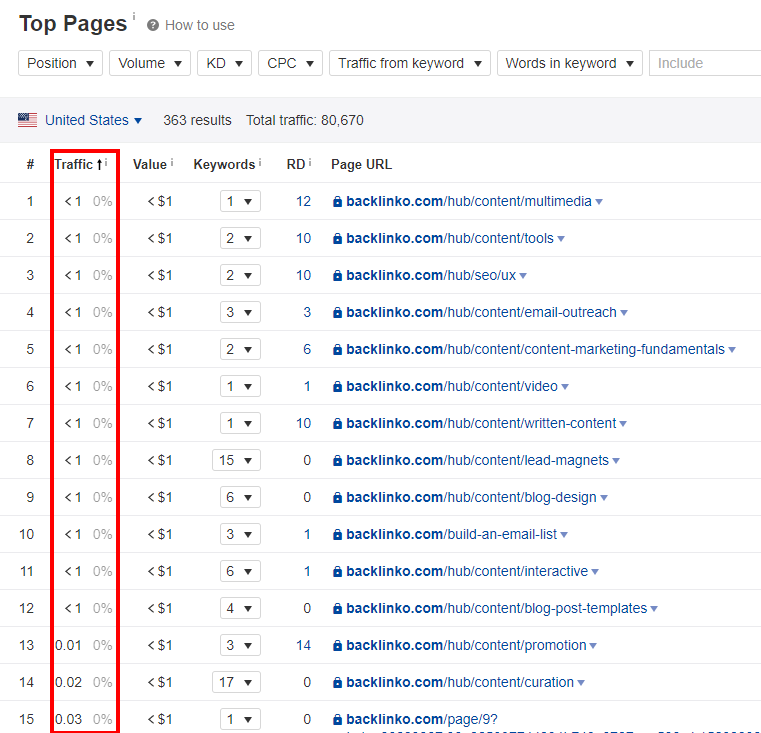
In fact, he has tons of pages that receive little to no traffic.
But he didn’t give up.
Regularly creating great content is the key to success. Many people try this technique once and expect it to work immediately. What they fail to realize is that all the pieces work together and that smart SEO tactics, employed consistently, will boost all the content on a site. It may happen gradually, so be patient. Don’t expect it to be an overnight success.
Here’s how it works: One awesome piece of content might earn 20 links, which can help another awesome piece that earns five and another that earns 50. Over time, all your pieces will climb, so plan on applying the Skyscraper Technique to every piece on your content calendar for the next six months to a year (and then the year after, and the year after that…).
If you’ve ever heard the quote, “A rising tide lifts all boats,” you can imagine how sound SEO practices can bear out this philosophy: All the boats (er, posts) will be lifted over time, so stick with it and trust the process.
Mistake No. 3: Thinking all search intent is created equal
A careful analysis of search intent is necessary for any piece of content. And it’s even more important when building Skyscraper content.
Sometimes, when trying to outdo competitors, we lose sight of what the searcher really wants and needs. This is a sure way to wind up shooting at the wrong target, wasting valuable time and energy on content that — while great — is serving the wrong audience and answering the wrong question.
This happens because common phrases can have more than one intent, so it’s important to know the difference between an informational search and a transactional search.

For example, a search for “accounting services” can be either transactional (if you’re looking for an accountant to prepare your taxes) or informational (if you want to learn what an accountant does for businesses or private citizens). So, it’s important to note which audience you’re looking to serve and study the currently ranking pages before taking action.
It’s also a good idea to apply the Skyscraper Technique to a more detailed, discrete subtopic related to the problem your audience is looking to solve. Then build a post around that subtopic, instead of trying to climb the steep SEO hill for a widely used and competitive search term.

Mistake No. 4: Thinking longer is always better
Dean and Neil Patel long espoused the undeniable value of creating the longest posts on the web. For many years we did this for our clients, and it works. But at some point, longer stops being better.
Say it with me: “Bigger DOES NOT equal better!”
We learned this fact the hard way last year, when we were dead-set on outranking the Backlinko piece detailing the best SEO tools out there — nearly 200 of them in all. To do that, we assembled a list with about 100 additional tools and provided brief capsule descriptions of each one.
Sounds great, right? An all-in-one resource that’s going to be THE authoritative post on the entire interet when it comes to the best SEO tools. Trouble is, the post got monotonous, and the content blurred together quickly. Readers tended to scroll for a while, get intimidated by the giant colums of text, and click off. That was terrible for our time-on-screen metrics.
A better approach might have been breaking the mega-list into several smaller ones, separating out the 10 best tools for different user groups — or ranking or grading the top 50 tools we liked at the time, then updating the list quarterly to tease new additions via social media.
Lesson Learned: Just because someone else’s post ranks today doesn’t mean your new post will rank by playing the same game. You might not be taking advantage of a variety of factors that helped the original post rank, such as:
- Your competitor has a long history of user click-through data
- Your competitor is on a domain with established authority
- Your domain authority is likely not equal to theirs
Mistake No. 5: Sacrificing user experience for extra content
In a similar vein, it’s also common to think that putting MORE into a post — more words, more boxes, more images, more more more — is going to help you rank. But you need to keep user experience and ease of use at the forefront of all your decisions. Serving the user best should be your primary goal.
It’s crucial to think about the reader’s “journey” through the post and make it as inviting as possible. Google uses dwell time and other user experience metrics to decide what ranks. So if you’re looking to build a new template or checklist, all you need to do is create the template. Make it quick and easy for the user so they’ll want to hang around, give the post a full read, and download a free asset or fill out a contact form.
A shorter piece and opportunity to connect with a free resource can be just as valuable as a Wikipedia-length post densely loaded with keywords. When you serve the search intent of the user best, she’s far more likely to share it with colleagues, link to it, and take other steps that will increase its visibility organically.
Mistake No. 6: Punching outside your weight class
“If the keywords you’re targeting are very competitive and you’re going up against the most authoritative sites on the web, your site may not be ready, no matter how great your content.” (CLICK TO TWEET!)
This quote is not meant to say that ranking is impossible for extremely popular keywords — just that it might not be worth the time and investment needed to make yourself competitive. If it takes you as long to win the term “CRM” as it would to produce and rank five terms like “hubspot vs salesforce,” you’d be far better off doing the latter.
In short, pick fights that you can win. Beating up the smaller crowds of outlets making plays for less-competitive but still valuable phrases will pay off with greater visibility among your audience.
To restate a point that bears repeating: Spend lots of time doing smart keyword research, and then do some more. Gradually, you can build up the authority to take swings at shorter, ultra-competitive terms. But you may have to live with results that might be humbling, even if the content is premium-grade.
Mistake No. 7: Failing to account for the lift that comes from being a recognized authority
There’s huge value in building and maintaining a great reputation as an expert in your field. You’ve got a big advantage if you’re Brian Dean or Neil Patel, with years of high-profile experience to back up millions of words of post content. It’s several orders of magnitude easier for them to rank highly for just about any terms that appear in their posts.
To the victors go the spoils, right? But if you’re just getting started writing about your industry, you’ve got a long road ahead of you to attain a similar level of authority.
Besides the benefits of a well-known personal brand, any web asset attached to a known expert’s website will benefit from years of domain authority. They’ll also get a boost from the trust equity they’ve accrued with search engines.
There’s a good reason for this: Search engines want to deliver great content experiences to visitors. As a result, sites that have demonstrated an ability to draw and retain readers for years will jump to the head of the line.
This one-two punch may seem unbeatable if you’re a newcomer to a field. But the only way to start getting wins is to do the work of making great content — whether you use the Skyscraper Technique or not. Then do everything you can to get it seen as widely as possible.
Mistake No. 8: Extending outreach only toward the folks who linked to the pages you’re trying to beat
If your competitors have 300 links to their pages overall and you start with performing outreach to all 300, you should be delighted to get 30 links. A 10 percent conversion rate is awesome. But it’s likely not enough to knock the leader out of the No. 1 spot.
The old reliable 80/20 rule comes in handy when putting together a plan to promote your great content. In this case, it means you should spend about 20% of your time creating the content, then dedicate the other 80% to the grind-it-out work of building a DEEP list of prospective sites to reach out to.
You need to prospect far outside that base and start the outreach when you have 6,000 prospects. Then, bank on a conservative 5% conversion rate in order to come close to 300. This requires outreach creativity and identifying all the folks who might be interested in your piece. Brainstorm all the possible audiences and angles, then go after them one at a time.

It helps to adopt a sales mentality and understand that a success rate in the mid-to-high single digits is exceptional. Just like in sales, it will pay off to study and learn the best practices for outreach. The internet is littered with template emails for this kind of thing, so find one and tailor it for your voice and character.
Constant testing and tweaking will help to improve your performance and boost your conversion rate closer to 10% on that list of 6,000 prospects…. Just think of how well a post with 600 (!) backlinks will perform! Feeling motivated yet? Good.
How to Succeed at the Skyscraper Technique
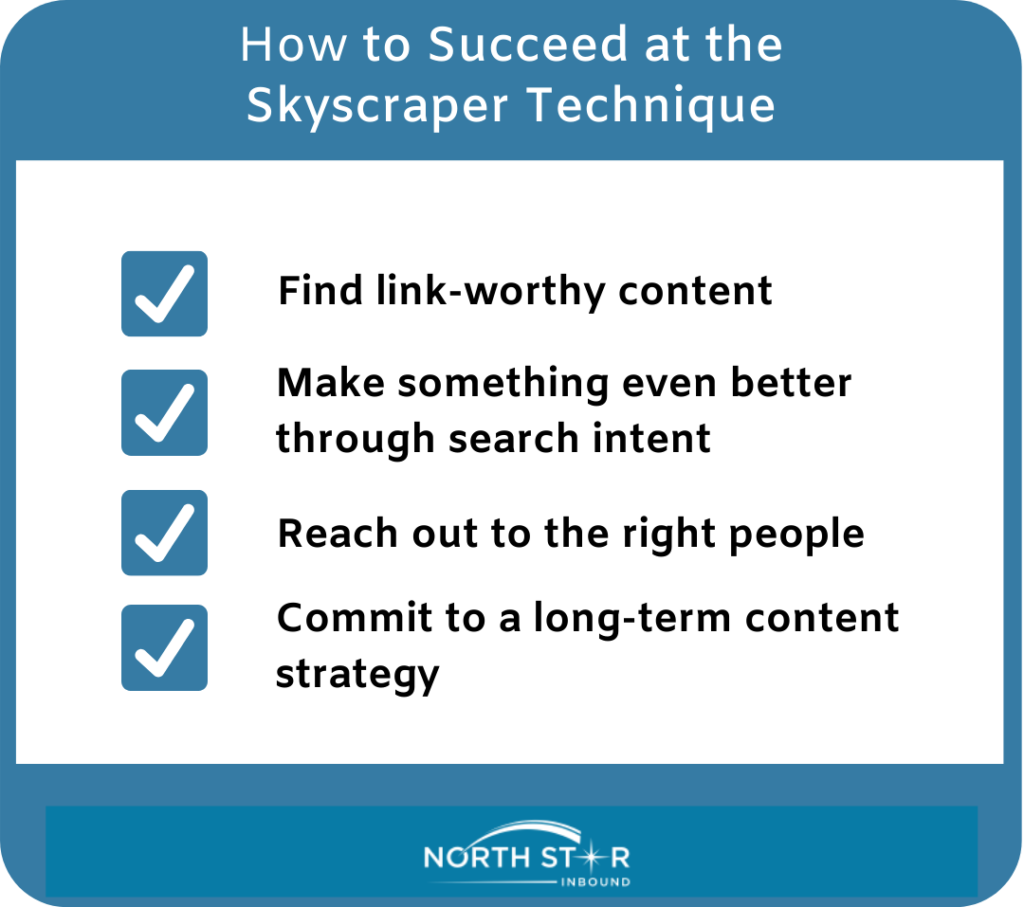
We believe that the core ideas of the Skyscraper Technique can lead to wins that result in better positioning in Search Engine Results Pages over the long haul. It’s just that the technique has A LOT of fine contours, and it’s easy to get tripped up and discouraged along the journey.
If you acknowledge ahead of time that there’s no way to snap your fingers and devise a one-size-fits-all approach to SEO, it will save you a lot of frustration. Then you can focus on putting in the hard but worthwhile work of making content that can stand out as superior to that of your competitors.
Find link-worthy content
A few tools you can use to hunt down awesome link-worthy content in your niche include:
Personally, we find Ahrefs to be one of the best tools to use when researching link-worthy content. You’ll want to navigate over to “Content explorer” and look up the keyword or phrase for the topic of choice, like this:

Once you do that, you’ll decide on a few things, like where you want your keyword to be within the results (Everywhere, In title, In content, In URL) and when the page was published.
Pro Tip: Start with “Everywhere,” but depending on your niche, you may need to toggle between “Everywhere” and “In title” to get the best results.
In return, you’ll receive a link with the most relevant pages to your search, complete with useful metrics like referring domains and domain rating.
Pro Tip: Make sure to sort your results by “Referring domains” in order to see the pages with the most links at the top.
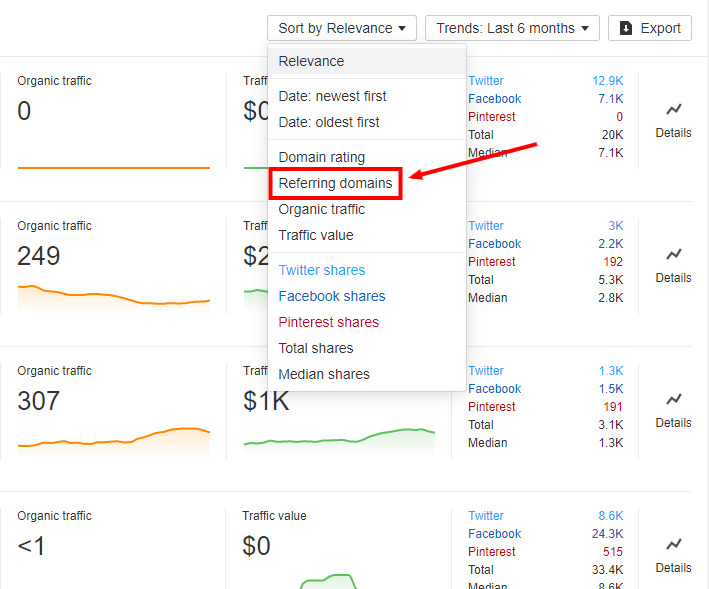
Once you have this, you can comb through the results to find some inspiration.
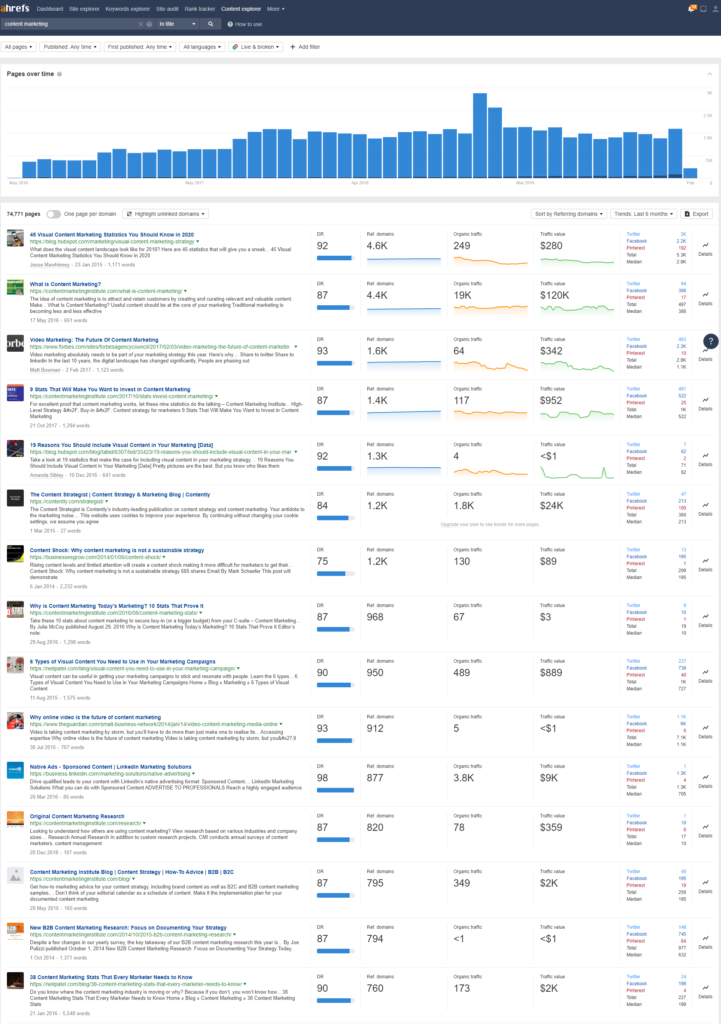
If you already know the URL of a good place to find amazing content, you can navigate over to “Site explorer” to find the most linked-to content on that website. Like this:

Once you do that, you’ll want to navigate in the menu to Pages > Best by links and find their top-performing pages for inspiration. Keep in mind that you’ll likely be seeing homepages and product pages, as well.
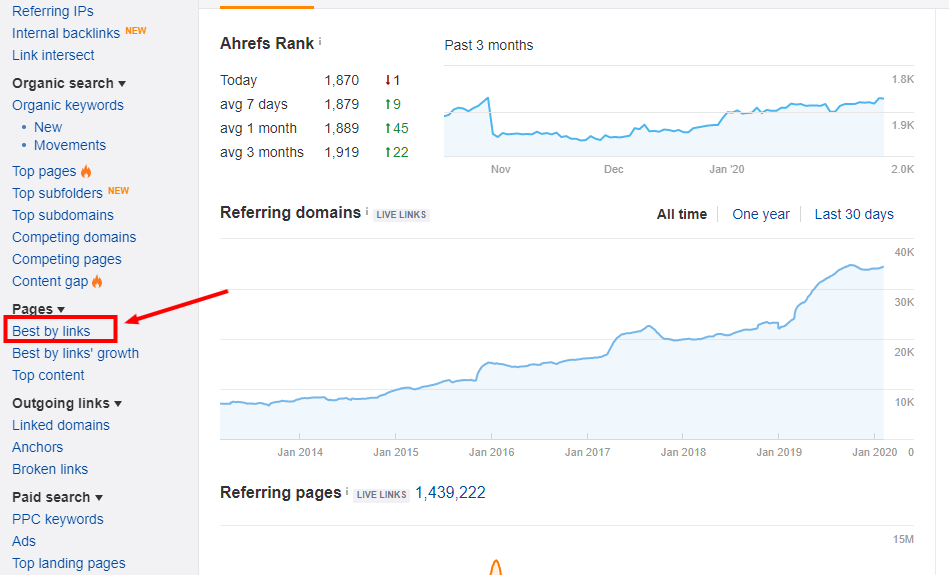
This type of research provides an insightful, data-driven starting point on which pieces to dive into for inspiration. We don’t agree with all the results, but it’s still an opportunity to conduct research, check out the number of backlinks, and find out where they’re coming from. That will matter A LOT for Action Item No. 3, below.
It’s important to gather as much raw material for your own content as possible. It’s easy to do so by scanning the top results. Then jot down bullet points of what you like, what you want to debate or shoot down, or what you want to expand on with your own views and data.
Be sure to give credit and attribution wherever it’s due. The quickest way to kill your reputation and torpedo your rankings is by getting dinged for plagiarism. But it’s fair to think of your own content as a cocktail, with ingredients or inspiration gleaned from others in the field. Just make sure that what you’re saying is fresh, unique and valuable to the readers you’re trying to reach.
Don’t forget: Choose your keywords carefully based on competitiveness and opportunity.
Make something even better through search intent
Your keyword research and persona development should provide you with plenty of intelligence on what information your readers are looking for, and what problems they’re trying to solve. Search intent has a lot to do with the actual words, suffixes, and prefixes that are used, and how they apply to the situation(s) your readers find themselves in. For example, the search for “dream boyfriend” delivers back a bunch of results about a Japanese video game in which you can create your very own *dream boyfriend.*

Contrast that with a search for “dreaming boyfriend,” which delivers results tailored to anyone looking for answers related to the act of dreaming about a boyfriend.
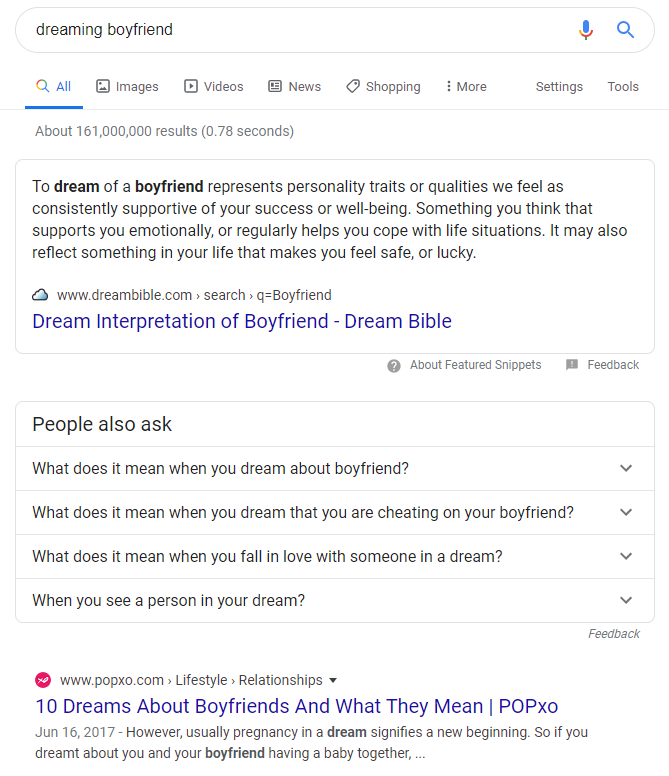
If you were writing a piece on the “7 Dreams You Can Have About Your Ex-Boyfriend & How to Interpret Them,” you wouldn’t target “dream boyfriend,” because the search intent doesn’t match. Instead, you’d target “dreams about ex-boyfriend” and study the pieces that already rank. Then you’d figure out what makes them special and how to provide fascinating, relevant content on the topic.
Whichever intent you’re trying to serve, honor the searcher and be the page that serves it best. This can be done by looking at the search engine results pages to see what Google thinks the search intent is based on the content it’s ranking.
From there, try to figure out why those results are in the top 10 and sift out those that aren’t relevant. Taking this step will keep you from muddying your search performance and help you stay within your target audience.
Build out a robust outreach database
In order to build a page with hundreds of links, you’re going to need to run outreach to thousands of sites.
You can, of course, start by gathering info on sites that have already linked to high-ranking content in your niche. The operative word is “start,” since that approach will get your list into the hundreds. It’s important to remember the 10x mantra and go for multiple thousands of target sites.
Get ready to love looking at a multi-page Excel workbook with contact info on every conceivable blog, news site, and related site you can imagine.
As noted earlier, the content promotion should take up 80% of your time (as opposed to 20% writing and producing it). Plumb your existing network of contacts in the field and go two or three levels deep into their networks by analyzing social media platforms, especially LinkedIn and Twitter, to build up more targets.
Online tools like Followerwonk will make it easier to uncover influencers and people you may not know about who can make waves in an industry. These are your whales. Their endorsement in the form of a link or social media post can make a piece of content take off like it’s strapped to a rocket (or reach into the stratosphere like a skyscraper).
Don’t just reach out to bloggers, publications, and influencers within your particular space, but also brainstorm to identify related topics or fields that might be interested in your content.
For example, if you’re writing about SEO, consider reaching out to publications in adjacent digital marketing niches that might also be interested. Think social media, PR, content marketing, entrepreneus, startups, and small business. Also think about industry-specific blogs that may also write about marketing from time to time and add them to your working list.
Commit to a long-term content strategy
Lay out a content strategy that pinpoints which topics you want to write about over the course of your next quarter, six months, or 12 months.
Call us crazy, but there is a bit of serenity that comes from plotting out the work you’re going to do far in advance and building smart campaigns of content around specific keywords and topic clusters. The calendar and the goal-setting that informs it will set you up for success, so enjoy the process and the knowledge that following through WILL pay off.
Don’t let one seemingly failed piece keep you from continuing your efforts. Just like building a skyscraper, it takes tons of consistency to create something massive.

The Bottom Line
Got all that? It’s important to note that the Skyscraper Technique has become a foundational SEO tactic for a reason: It works. And it’s built on sound thinking about how visitors look for and interact with content today.
The big drawback is that it’s very often touted in blogs and videos as a quick fix that will land just about anyone on the first page of Google results.
The truth is this: Although using the Skyscraper Technique can produce noticeable results over the long term when used consistently, there’s considerable danger in expecting mad results (even from exceptional content) if you fail to follow the other important steps outlined above.
We’ve told you what NOT to do when trying to Skyscraper your way to content dominance. And you’ve seen in detail how to properly employ the technique’s three key steps. All that’s left to do now is start building your reputation and superior online standing, one towering post at a time.





